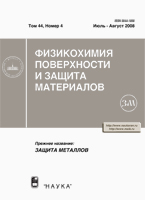A  Geometric Model
Geometric Model of Glass-Enamel Coating. Part 2. Contact Area with Metal, the Gas-Phase Volume Fraction, and the Minimum Coating
of Glass-Enamel Coating. Part 2. Contact Area with Metal, the Gas-Phase Volume Fraction, and the Minimum Coating s Cross-Section
s Cross-Section
N. T. Shardakov and V. Ya. Kudyakov
Institute of High-Temperature Electrochemistry, Ural Division, Russian Academy of Sciences,
ul. S. Kovalevskoi 20, Yekaterinburg, 620219 Russia
Received June 12, 2004
Abstract — In terms of a geometric model, an equation of the minimum cross-section area of a glass-enamel coating, as well as its particular form to calculate the contact area between the coating and the metal substrate, is derived. The expressions to assess the gas-phase volume fraction in the coating and its density are also obtained. It is shown that tearing the coating off occurs most probably in the plane of the minimum coating’s cross-section rather than the metal/coating interface.

